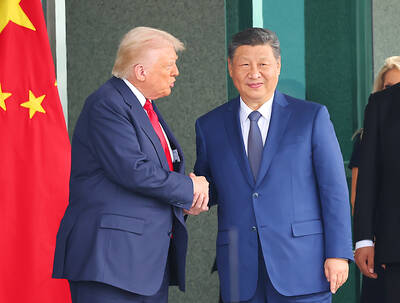The government would not be able to reach the power reserve margin target it set for 2025 if fails to commence operations at the coal-fired Shenao Power Plant (深澳電廠) as scheduled, the Ministry of Economic Affairs said yesterday.
The nation is likely to see a power shortfall by 2025, as the reserve margin is expected to decline 1.4 percent if the plant does not come online in July that year, the ministry said in a statement.
The government aims to improve the margin to 15 percent after next year from 7.1 percent this year by accelerating construction of several power plant projects, including expanding the Shenao plant in New Taipei City’s Rueifang District (瑞芳).

Photo: CNA
Upgrading the plant would ensure a stable power supply and improve energy efficiency, the ministry said, adding that the facility’s lower heating value — its efficiency taking into account the energy lost as water evaporates during combustion — is forecast to grow to 45 percent from 38 percent after the upgrades are completed.
Upgrades at the coal-fired Linkou Power Plant (林口發電廠) in New Taipei City are finished, the ministry said, adding that it would strike a balance between efficiency and environmental protection when upgrading the Shenao plant.
With more advanced equipment, the facility would be capable of reducing sulfur oxide and nitric oxide emissions, it added.
The ministry’s remarks came after the plant on Wednesday passed an environmental impact assessment, triggering renewed criticism over worsening air quality in northern Taiwan.
Environmental groups consider the Shenao plant upgrade to constitute a new project, as the original facility was mothballed in 2007 before being demolished in 2011, local Chinese-language media reported.
The government should invest more resources in the development of renewable energy resources, instead of generating coal-based energy, environmental groups have said.
The ministry said it assessed the possibility of replacing coal with natural gas at the Shenao plant, but the site does not have the space required to store the fuel.
Despite the government’s goal of generating 20 percent of the nation’s electricity from renewable sources by 2025, the ministry said it is still necessary to partly rely on coal-generated energy to ensure a stable energy supply.
Taiwan, an energy-dependent nation that imports nearly 98 percent of its fuel, is susceptible to fluctuations in global energy prices, the ministry said.
Coal-generated energy is seen as a more stable energy resource compared with renewable sources, as coal can be stored for 30 days, it added.

RUN IT BACK: A succesful first project working with hyperscalers to design chips encouraged MediaTek to start a second project, aiming to hit stride in 2028 MediaTek Inc (聯發科), the world’s biggest smartphone chip supplier, yesterday said it is engaging a second hyperscaler to help design artificial intelligence (AI) accelerators used in data centers following a similar project expected to generate revenue streams soon. The first AI accelerator project is to bring in US$1 billion revenue next year and several billion US dollars more in 2027, MediaTek chief executive officer Rick Tsai (蔡力行) told a virtual investor conference yesterday. The second AI accelerator project is expected to contribute to revenue beginning in 2028, Tsai said. MediaTek yesterday raised its revenue forecast for the global AI accelerator used

Taiwan Semiconductor Manufacturing Co (TSMC, 台積電) has secured three construction permits for its plan to build a state-of-the-art A14 wafer fab in Taichung, and is likely to start construction soon, the Central Taiwan Science Park Bureau said yesterday. Speaking with CNA, Wang Chun-chieh (王俊傑), deputy director general of the science park bureau, said the world’s largest contract chipmaker has received three construction permits — one to build a fab to roll out sophisticated chips, another to build a central utility plant to provide water and electricity for the facility and the other to build three office buildings. With the three permits, TSMC

TEMPORARY TRUCE: China has made concessions to ease rare earth trade controls, among others, while Washington holds fire on a 100% tariff on all Chinese goods China is effectively suspending implementation of additional export controls on rare earth metals and terminating investigations targeting US companies in the semiconductor supply chain, the White House announced. The White House on Saturday issued a fact sheet outlining some details of the trade pact agreed to earlier in the week by US President Donald Trump and Chinese President Xi Jinping (習近平) that aimed to ease tensions between the world’s two largest economies. Under the deal, China is to issue general licenses valid for exports of rare earths, gallium, germanium, antimony and graphite “for the benefit of US end users and their suppliers

Dutch chipmaker Nexperia BV’s China unit yesterday said that it had established sufficient inventories of finished goods and works-in-progress, and that its supply chain remained secure and stable after its parent halted wafer supplies. The Dutch company suspended supplies of wafers to its Chinese assembly plant a week ago, calling it “a direct consequence of the local management’s recent failure to comply with the agreed contractual payment terms,” Reuters reported on Friday last week. Its China unit called Nexperia’s suspension “unilateral” and “extremely irresponsible,” adding that the Dutch parent’s claim about contractual payment was “misleading and highly deceptive,” according to a statement